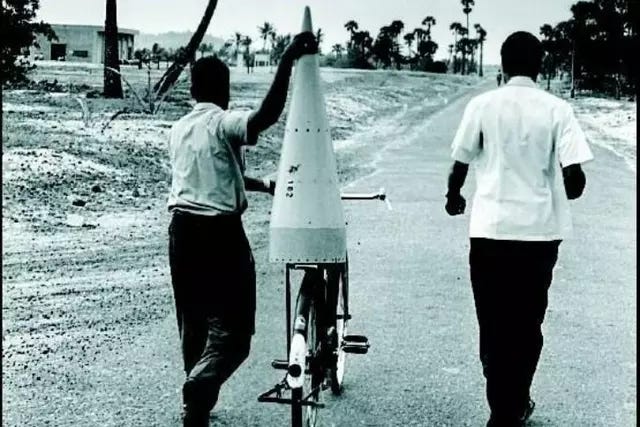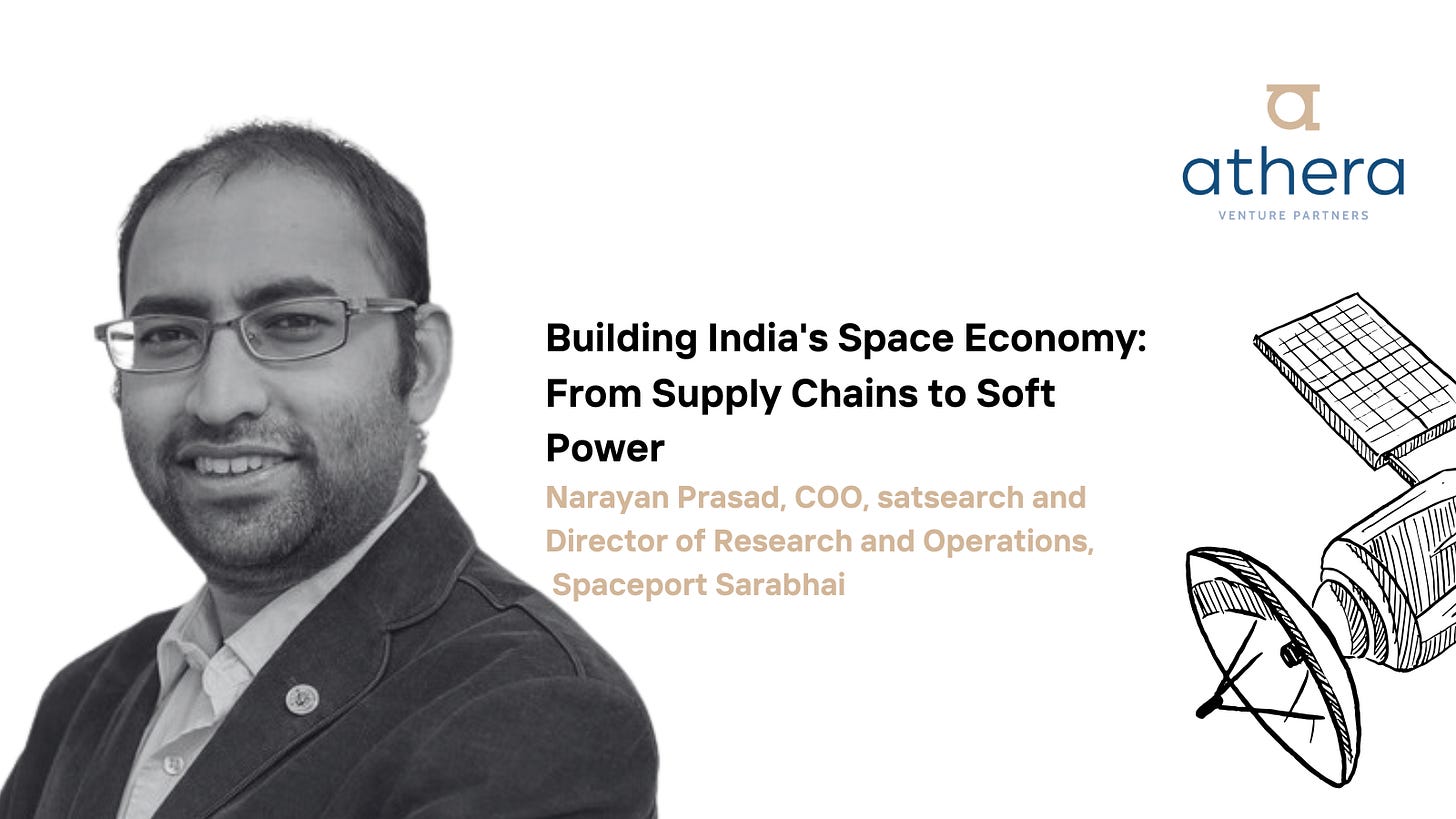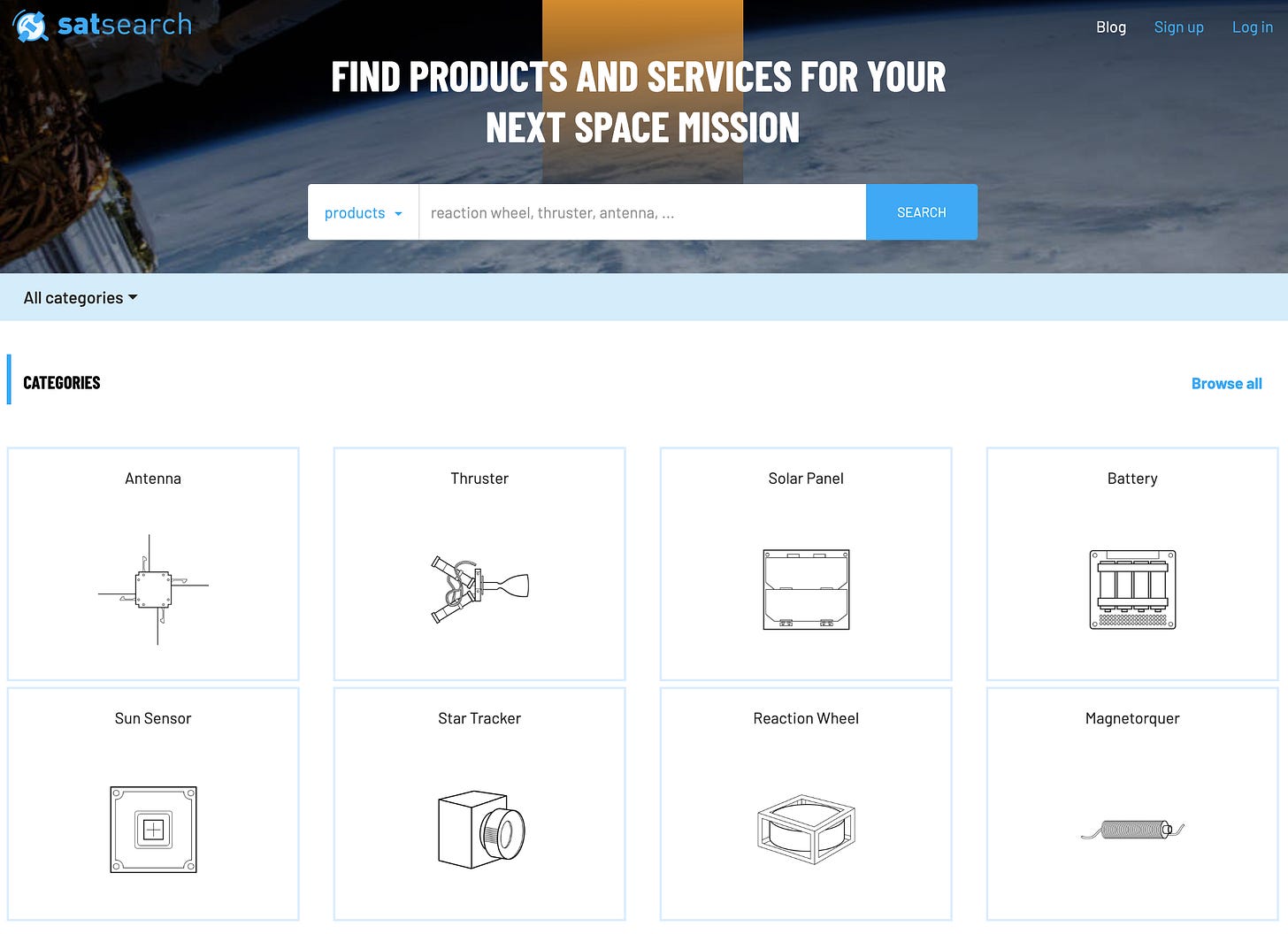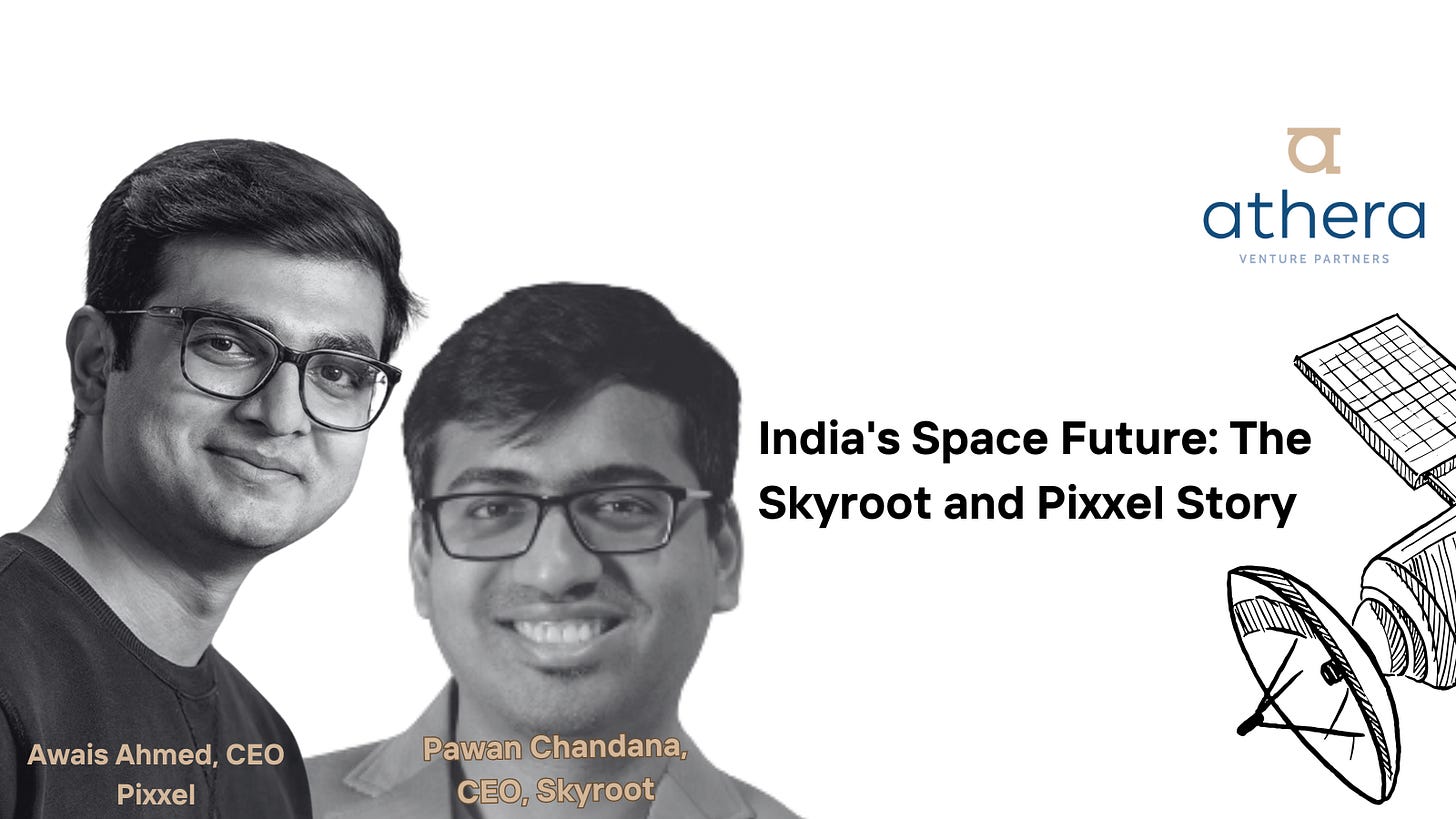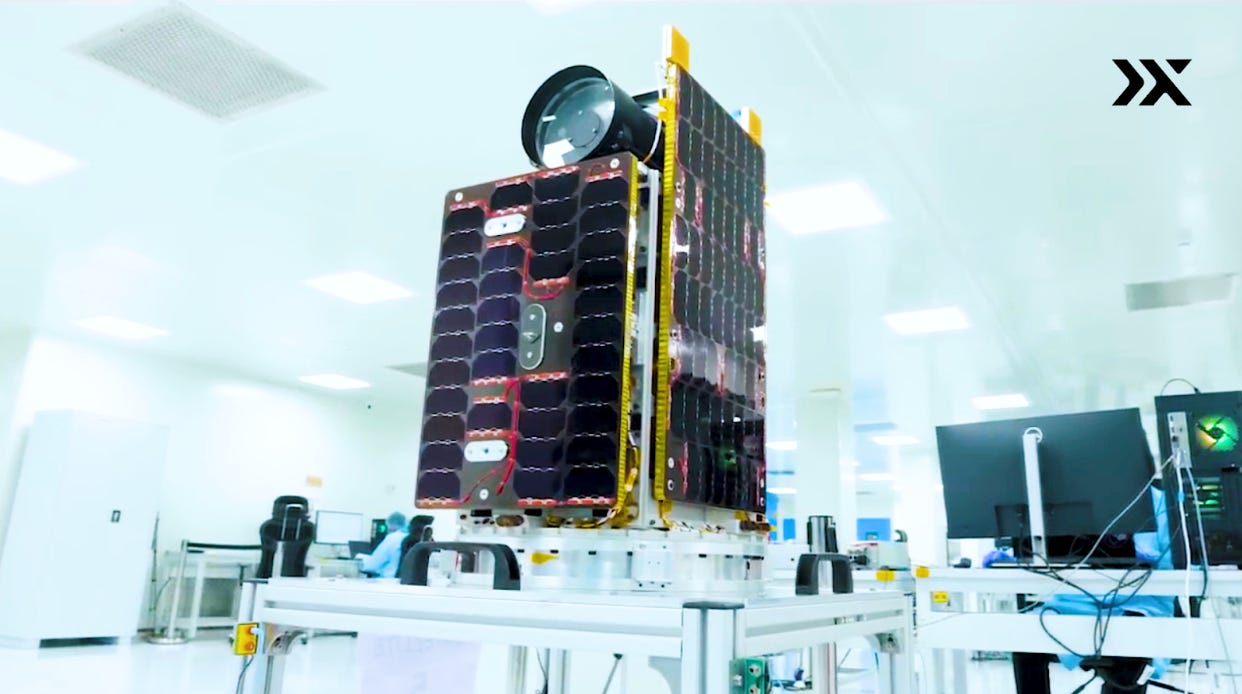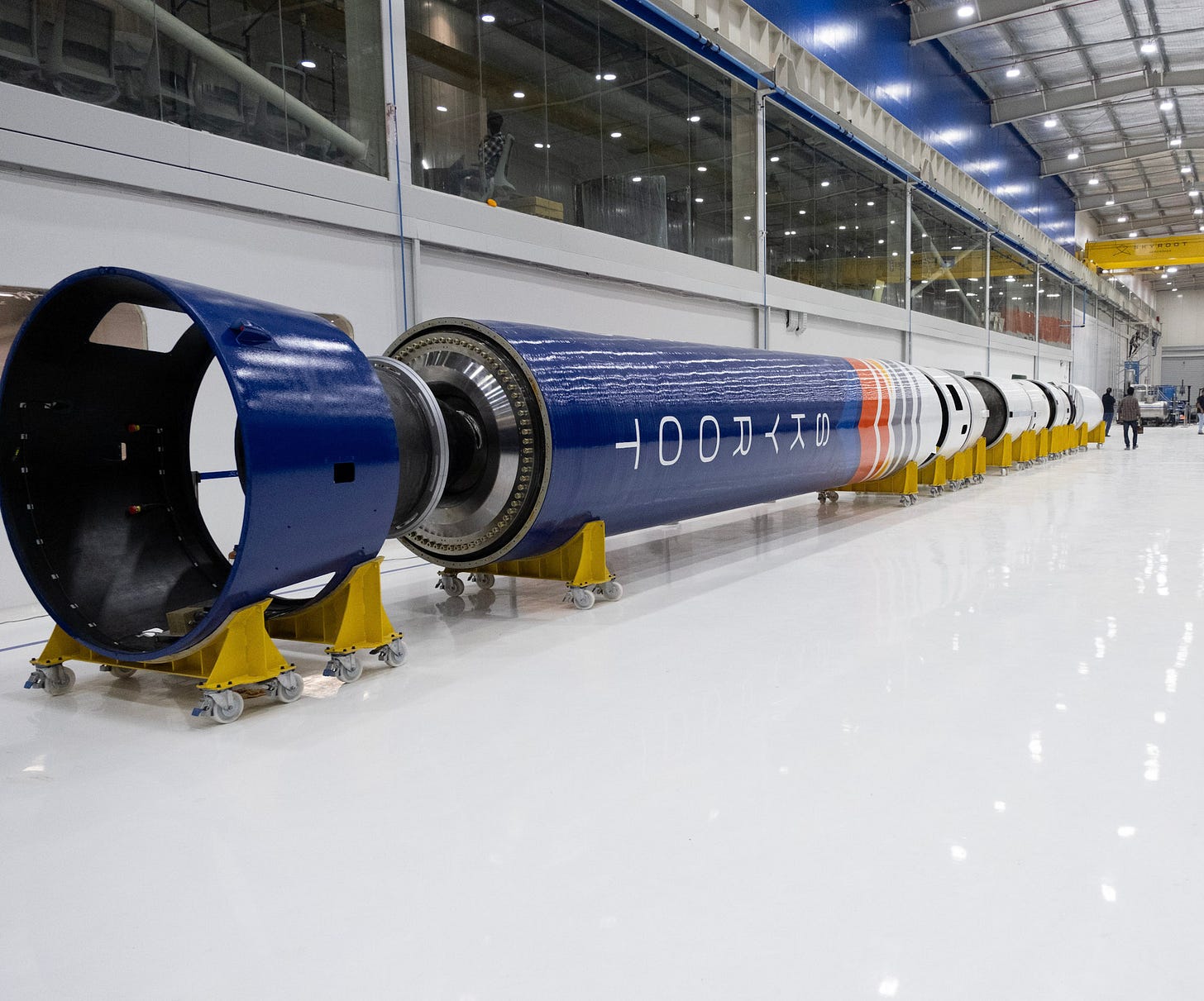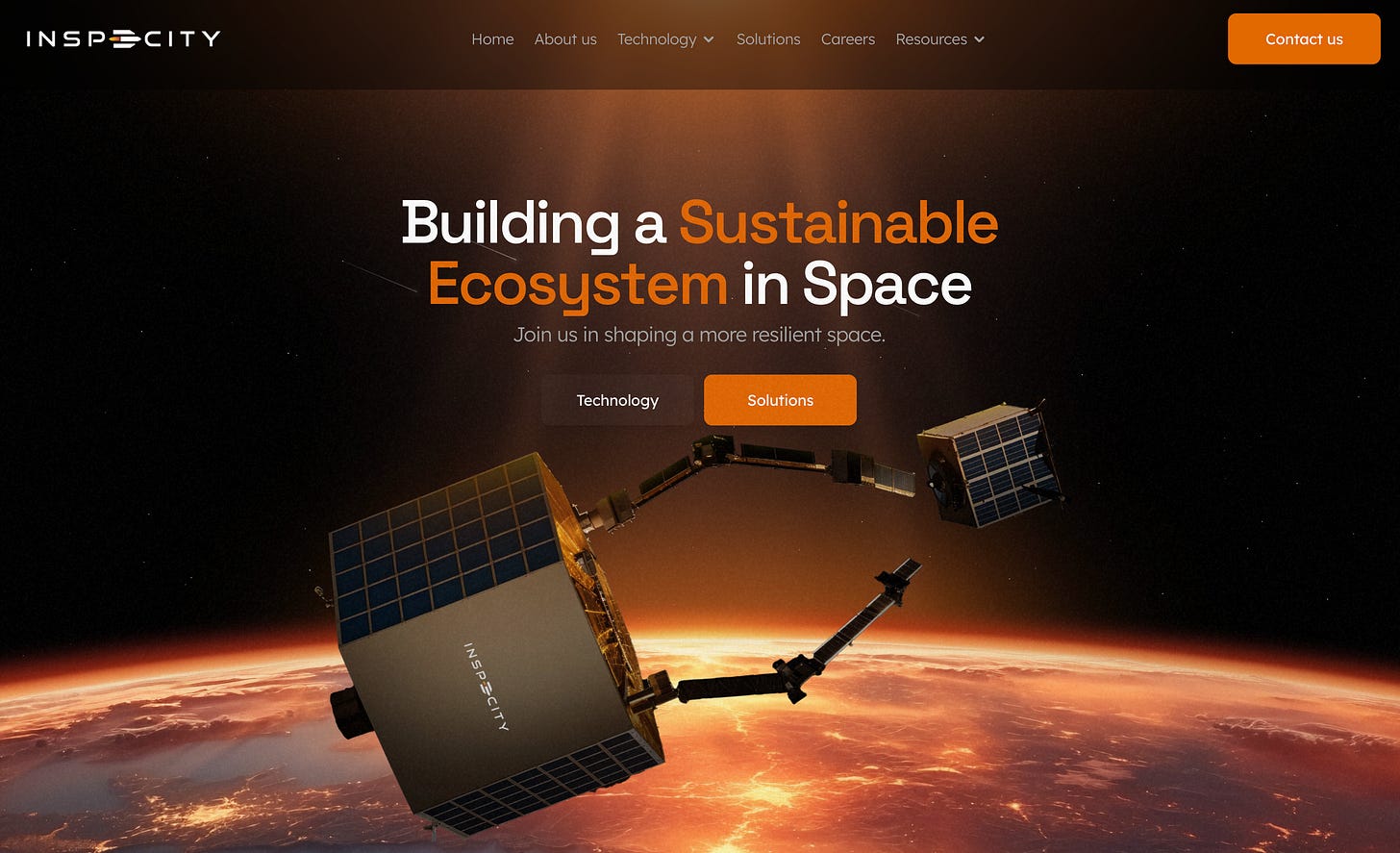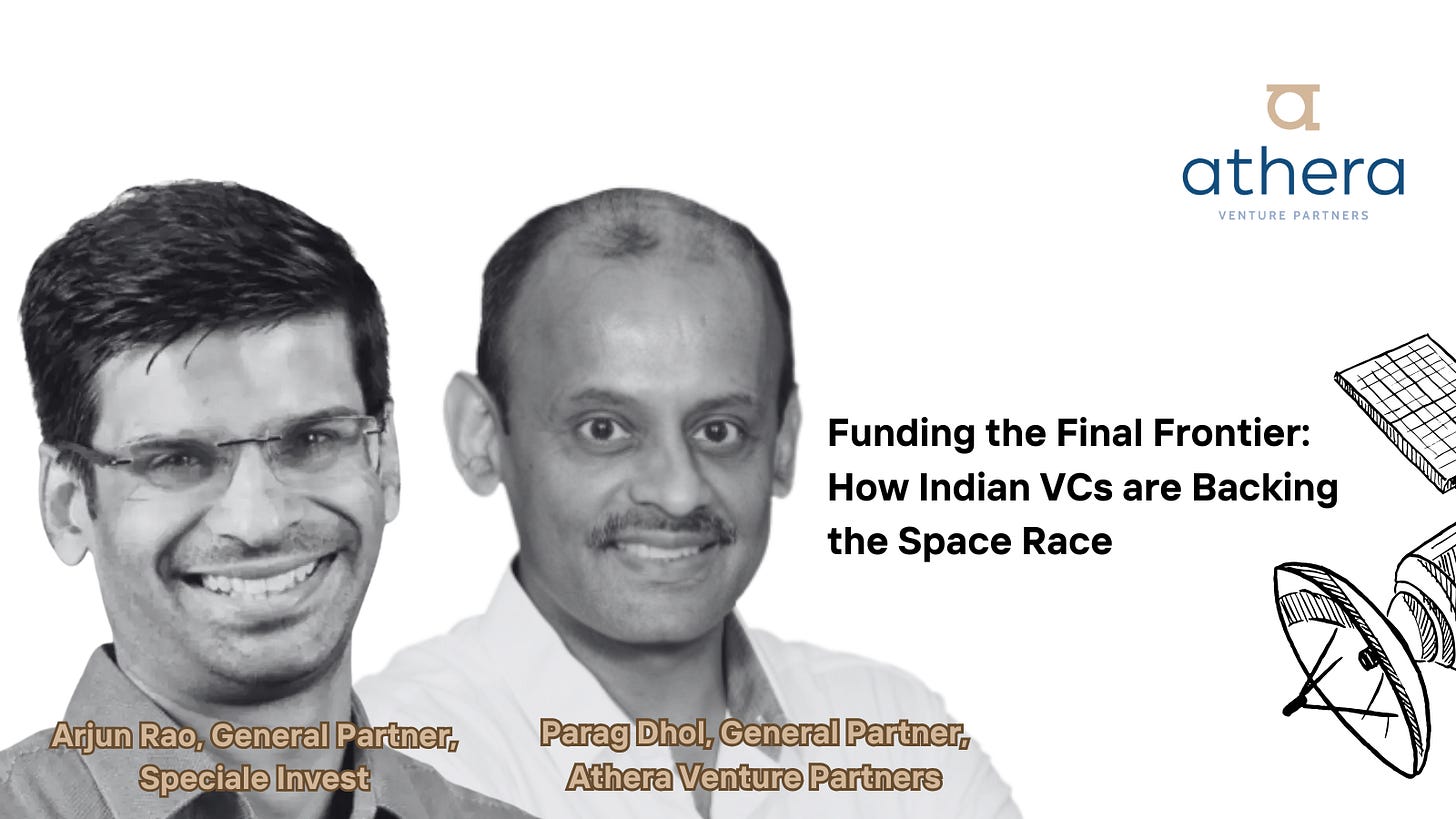December 2024 | Athera's Odyssey: The New Indian Space Age
India is entering a new space age. We try to make sense of it.
Merry Christmas!
In this month's edition of Odyssey, we explore India's flourishing space tech sector, which has made a mark on the domestic and global stage. We'll be using the lens of policy, academia, innovation, and venture capital to tell the story of our country's new space age. Featuring:
The Policy-Maker: Narayan Prasad of satsearch and Spaceport Sarabhai
The Builders: Awais Ahmed of Pixxel, and Pawan Chandana of Skyroot
The Prof-turned-Builder: Prof. Arindrajit Chowdhury of Inspecity
The VCs: Arjun Rao of Speciale Invest, and our very own Parag Dhol
Happy reading, and have a great 2025 ahead!
Remember when ISRO carried rocket parts on bicycles?
Today, Indian space tech has come so far that venture capitalists are writing million-dollar checks to twenty-something founders building everything from rockets to satellite repair robots.
Take Skyroot and Pixxel. One is building launch vehicles to open up affordable access to space, the other is developing satellites that can see what others can't.
Then there's Professor Arin, who left the comfort of academia to build India's foremost satellite repair service. Each represents a different piece of the puzzle in India's ambitious space plans.
What's fascinating isn't just what they're building, but how they're building it.
These aren't copycats of SpaceX or Blue Origin - they're uniquely Indian solutions.
When Skyroot needed testing facilities, they turned to ISRO. When Pixxel needed specialized components, they tapped into a supply chain built over 60 years of India's space program. It's a perfect marriage of governmental experience and startup agility.
The investors backing these dreams aren't your typical VCs either.
As Parag puts it, "We punch way beyond our weight in space. We were a very poor country when we sent our first satellite up, and it's just amazing."
They're betting on India's unique advantage - the ability to build world-class technology at a fraction of global costs.
But perhaps the most exciting shift is in ambition. "Just like Tiger Global increased the ambition levels of Indian entrepreneurs in 2010, Elon Musk has done that for space tech," notes Parag.
The challenges are significant.
Hardware is hard, space is harder, and the development cycles are long. But something has changed in the past few years.
The government, through IN-SPACe, has become an enabler rather than a gatekeeper. Global investors are taking notice. And most importantly, Indian talent that once could only dream of working in space through ISRO now has options.
In this edition of Athera's Odyssey, we dive deep into three different perspectives of India's space story - the launch pioneers, the satellite innovators, and the orbital mechanics. Together, they paint a picture of an ecosystem that's reaching for the stars, not just metaphorically but literally.
As Professor Arin reminds us, "If a door is closed, just knock on it. It might open."
For India's space sector, those doors are opening wider than ever before.
Building India's Space Economy: From Supply Chains to Soft Power
The story begins with a weekend hackathon in Bremen, Germany, in 2015.
"It was probably one of the most successful hackathons in the world," Narayan Prasad, co-founder of satsearch, and Director of Research and Operations at Spaceport Sarabhai recalls, noting that even today, four companies from that event still operate, with one recently achieving a €20 million exit.
Among these success stories is satsearch, which identified a critical gap in the space industry: the lack of a centralized resource for supply chain information.
The global marketplace for space, satsearch features space products, sub-systems, components, software, and services from suppliers around the world.
While industries like automotive and electronics have established players making supply chains transparent, space remained fragmented.
The reason?
For decades, space supply chains were circular, controlled by government missions and taxpayer dollars, with a focus on keeping production local. This model, while serving national interests, limited economic efficiency and global competitiveness.
Today, satsearch serves 30,000 engineers monthly across 120 countries, helping about 800 organizations with procurement. Their mission extends beyond mere commerce – they're building a platform that could fundamentally reshape how space technology is bought and sold globally.
India's Unique Position
What makes India's space journey particularly interesting is its historical context.
Unlike the West, where private industry preceded space programs, India's journey began with government initiative.
"In the sixties, when the space program took off, and then in the seventies, when the industry was tried to rope in, actually no industry really wanted to participate in space," Narayan explains.
The challenges were clear: low volume (one satellite every five years), technology restrictions, and significant investment requirements. ISRO's solution was innovative – they created a committee that would provide technology, know-how, and assured buyback to industry partners. While this de-risked the business for companies, it created a unique challenge: most Indian space companies don't own their intellectual property.
This has led to two distinct ecosystems in Indian space:
Traditional companies feeding into ISRO's ecosystem, building on ISRO's IP
New space companies developing their own IP for global markets
The Policy Imperative
For India's space sector to truly flourish, several policy interventions are crucial. Narayan emphasizes the need for the government to act as an anchor customer, particularly for upstream space companies.
"Without that kind of anchor customer model on the upstream of space, it's a very challenging business to execute," he notes.
He draws parallels with other high-tech industries: "Airbus and Boeing exist because European and American governments are the anchor tenant customers."
This model isn't about handouts. It's about creating a sustainable ecosystem where companies can develop products, establish heritage, and then compete globally.
Another crucial area is the integration of space technology with other sectors.
A prime example is the potential automation of toll collection using satellite technology integrated with UPI and vehicle systems. Such initiatives could dramatically improve economic efficiency while creating new markets for space technology.
The Role of Think Tanks
One of the most interesting developments in India's space ecosystem is the emergence of independent think tanks like Spaceport Sarabhai.
Unlike industry associations, these organizations provide independent analysis and facilitate connections across sectors.
Their initiatives include:
Documenting space history through interviews with veteran scientists
Organizing the first space startup pitch events
Facilitating Indian companies' presence at international exhibitions
Creating fellowship programs to enable technology transfer
A significant achievement was convincing ISRO to share exhibition space with Indian companies at international events. At a recent conference in Milan, 17 Indian companies were represented at the ISRO stand, marking a shift in how India presents its space capabilities globally.
Challenges and Opportunities
A significant challenge for Indian space companies is market perception. "The mistake that I see a lot of Indian entrepreneurs make when they come abroad is that they start this conversation saying that we are the cheapest solution in the world," Narayan observes.
This approach can be counterproductive in a high-reliability market where quality is paramount.
The opportunity lies in creating integrated solutions that combine space technology with other sectors.
Narayan envisions the most successful teams being those that bring together diverse expertise – "a GIS engineer teamed up with a banking expert, teamed up with somebody who has cloud infrastructure knowledge."
The Path Forward
For entrepreneurs entering the space sector, Narayan's advice is clear: avoid the echo chamber.
The real opportunities lie not in competing in existing markets but in discovering entirely new applications for space technology, particularly in developing markets where understanding local context is crucial.
"Solutions brought from the West will not translate very well to India," he notes. "You need to have the local cultural context to be able to solve the problem of the market." This understanding, combined with space technology, could create solutions that scale across Southeast Asia, Africa, and Latin America.
India's space sector stands at an inflection point. With the right mix of policy support, private sector innovation, and cross-industry collaboration, it has the potential to create solutions that not only serve India but can be exported globally.
India's Space Future: The Skyroot and Pixxel Story
Picture this: It's 2018, and a group of scientists from ISRO decide to quit their stable government jobs to build rockets.
There's no policy for private companies to launch rockets in India.
No clear path to success.
Just an audacious belief that India's space sector is ready for change.
This was how Skyroot began. "We took a leap of faith," says Pawan Chandana, co-founder of Skyroot.
Around the same time, fresh graduates from BITS Pilani were poring over satellite images, asking a simple question: what if we could see more? This curiosity would lead to Pixxel, a company building satellites that can see what others can't.
Why Space? Why Now?
While launch services might seem like a small piece of the space economy – just $10 billion of the current $400 billion market – it's the gateway to everything else.
"It's the key to get to space," Pawan explains simply.
Without reliable, affordable launches, the projected $1.8 trillion space economy of the next decade remains just that: a projection.
For Pixxel, the opportunity came from a gap in the market. Playing around with different types of satellite data, they stumbled upon hyperspectral imaging.
“When we analyzed hyperspectral data, we were like, wow, there’s an opportunity here." recalls Awais Ahmed, of Pixxel. Here was technology that could reveal everything from forest health to mineral deposits, and surprisingly, no commercial company was providing it.
The Policy Breakthrough Nobody Expected
Then came 2020.
In the middle of a global pandemic, something unexpected happened: India opened its space sector to private players. The government created IN-SPACe, a new agency to support private space companies. The impact was immediate.
"The government worked for us to meet our time limits," Pawan shares, still sounding slightly amazed. They received their launch authorization just a day before their historic launch – the kind of speed unheard of in the space sector globally.
The Money Story and ISRO Connect
Raising money for space isn't easy. When Skyroot started, Pawan didn't even know what equity meant. But sometimes, stars align.
A LinkedIn message to Mukesh Bansal (of Myntra fame) led to a 45-minute meeting and a check in crores – with zero expectations.
Pixxel's story started with alumni from their college, BITS Pilani, backing them almost as an act of faith. "If it works, it's good for BITS, it's good for India," was the thinking. Today, they count Google among their investors.
Perhaps the most interesting shift has been in how ISRO, once the sole player in Indian space, has embraced these startups. Private companies can now use ISRO's testing facilities – saving millions in infrastructure costs. More importantly, they can tap into an ecosystem of suppliers built over 60 years.
Space is hard. As Pawan puts it, they're "battling with physics every day." There's an old NASA saying that every space project takes twice as long and costs thrice as much as planned – even after you account for this rule.
But both founders maintain that impossible timelines are necessary. As Awais puts it, "If you keep a realistic timeline, then that gets delayed. But if you keep an ambitious timeline, hopefully that gets delayed to a realistic timeline."
What's Next?
Skyroot is gearing up for orbital launches – the real test of any rocket company.
Pixxel plans to launch six satellites next year, creating what Awais calls "a health monitor for the planet." They'll track everything from forest changes to ice caps and pollution levels.
But perhaps the most exciting development is what's happening in the broader ecosystem. India now has over 200 space startups. Major venture funds, once skeptical of hardware companies, are actively looking at space deals.
As Pawan puts it, "We're building a generational company."
These startups are showing that Indian companies can do more than provide low-cost alternatives – they can innovate, lead, and possibly reshape how humanity uses space.
The Professor Who Left His Comfort Zone to Fix Space
"Everything that has electromechanical components is bound to fail," Prof. Arindrajit Chowdhury explains, leaning back in his chair.
"Satellites are no exception."
It's a simple observation that led him to leave his comfortable position at IIT Bombay and venture into the uncertain world of space startups.
From Campus to Cosmos
The transition wasn't easy.
"Being a professor is awesome," he admits with a laugh.
"You're not really placed in a situation where you're motivated to go out of that ecosystem and do something as crazy as create a startup."
But after years of watching his students build technologies that never made it to market, frustration began to build. "I've seen enough of the students put their efforts behind it and not take it to the level that I'm happy with," he says. "Now, can I do it myself?"
There's a bigger problem looming over humanity's space ambitions - the Kessler Syndrome. It's a scenario where one piece of space debris leads to multiple pieces, creating a cascade that could potentially trap us on Earth.
"If that happens, we're going to be relegated to a type zero civilization," Prof Arin warns.
Building the Team: A Lesson from Rocket Science
When it comes to building his team of 25 people, Prof Arin draws an unexpected parallel with solid rocket propellants.
"In a rocket, you have oxidizers and fuels - different types of particles that need to be bound together by something called a binder," he explains. "A team is similar. You need passionate people with different energies, bound together by those who set the cadence, the beat of the march."
Interestingly, despite his IIT connections, he's deliberately avoided hiring primarily from the IITs. "We raised very little money, and what we're trying to execute is just plain nuts," he says matter-of-factly. Instead, he's built a team from across India's engineering ecosystem, focusing on fundamentals and passion over pedigree.
The Three Pillars
Inspecity focuses on three core technologies: robotics, rendezvous and proximity operations (RPO), and propulsion.
They're one of the few companies globally working on all three together. "We don't build the entire satellite," Prof Arin clarifies. "We partner for that. But these three technologies? We need to control them ourselves."
The approach is working. They're the only company to win two challenges under IDEX, India's defense innovation initiative.
At a recent DRDO event called Antariksh Shakti, they got the position of honour right at the entrance. "We could hold our ground," Prof Arin recalls proudly, "even when the Director of Future Technologies at DRDO started grilling us about six degrees of freedom equations."
The Bridge Builder and The Reality Check
Perhaps Prof Arin's most valuable contribution isn't just the technology - it's bridging academia and industry.
"Indian industry doesn't know how to work with Indian academia," he observes.
This academic network has become his "trump card." When technical challenges arise, he knows exactly which professor at which institute can help. It's how they've managed to move so fast with relatively little funding.
But he's also quick to offer a reality check to India's space startup ecosystem. Yes, ISRO's Chandrayaan-3 success has elevated India's space reputation globally. But startups can't simply ride on that glory.
"Just because the father or grandfather is very good doesn't automatically mean the kids are going to be very good," he admits.
"We have the benefit of the doubt today, but we have to continuously demonstrate things in space to reap the benefits of that doubt."
Looking Ahead
For now, Prof Arin is laser-focused on one goal: demonstrating their technology in space.
Despite his team's capabilities to do "many things," he's deliberately keeping the focus narrow. "I definitely don't want this company to be an engineering services company," he insists. "We want to build one product. We want to build it at scale. That's it."
It's this focus that might just help solve one of space exploration's biggest challenges. As humanity launches more satellites and ventures further into space, we'll need services to maintain and repair our space infrastructure.
India's space story is evolving from government missions to commercial ventures. Companies like in-space city represent a new breed of Indian startups - ones that aren't just providing services or building components, but developing cutting-edge technology to solve global problems.
Prof Arin's journey from academic to entrepreneur also signals a shift in India's innovation ecosystem. It's no longer enough to just develop technology in labs - someone needs to take it to market, to make it real.
As our conversation wraps up, Prof Arin shares one final piece of wisdom that seems to sum up both his personal journey and the broader story of Indian space tech: "If a door is closed, just knock on it. It might open."
For India's space startups, those doors are opening wider than ever before.
The question is, who will walk through them?
Funding the Final Frontier: How Indian VCs are Backing the Space Race
When two rocket companies pitched to Speciale Invest within two weeks of each other in 2018, Arjun Rao knew something was brewing in India's space sector.
"You sort of pause and say, hey, this is interesting," he recalls. Those companies - Skyroot and Agnikul - are now at the forefront of India's private space revolution.
But more fascinating is the story of how Indian venture capitalists, traditionally skeptical of hardware businesses, decided to bet on rocket science.
The Making and Unmaking of a Space Thesis
"We never believed in a thesis," says Parag Dhol of Athera Ventures, challenging conventional VC wisdom. Instead of starting with market sizing or competitive analysis, they let entrepreneurs lead the way.
When the Pixxel team came in with their vision for hyperspectral imaging satellites, "they just blew our minds," Parag recalls. Within a month, Athera had written a $500,000 check - breaking their own rule about not doing pre-seed deals.
But beneath this seemingly intuitive approach lay a rigorous evaluation framework. "You always look at two or three key aspects about any sector," Arjun explains. First was India's unique talent advantage, built on six decades of ISRO's work. Then came market timing - the dramatic fall in satellite building and launch costs coinciding with increasing demand for space-based services.
Risk and Reward: The Space Math
The economics of space investing are unique.
Traditional VC metrics like monthly revenue growth or user acquisition don't apply. Instead, investors focus on technical milestones and risk reduction.
"Can you correlate milestones to risk?" Arjun asks rhetorically. "If you get to that milestone, we can claim that if the risk was 70% it has come down to 45%." This milestone-based approach helps structure the long development cycles typical in space tech.
Parag offers a concrete example from Pixxel: "They had $75 million+ in option contracts around two years ago."
These weren't traditional purchase orders but commitments saying they would buy hyperspectral data when available. "They were already buying $5 million plus of multispectral data, who wanted to upgrade to high-quality hyperspectral data" he explains.
The Capital Conundrum
Space tech's capital needs are substantial but lumpy.
"The money requirement at certain stages is fairly significant," Parag notes. A typical Series A in SaaS might be $5-7 million, but space tech companies often need $10 million or more. This creates a unique challenge in India where, as Parag observes, "putting that $10 million together amongst let's say 10 of us who are willing to do it in this country is how it is working out currently."
This capital constraint has led to innovative structuring. Speciale's approach is to start small but be ready to double down. "The first check was about half a million," Arjun recalls about one investment. "We used to write 300k cheques... but for some weird reason we had conviction, we said okay we will make one exception."
Beyond Launch: The Real Opportunities
While launch vehicles grab headlines, both investors see bigger opportunities elsewhere. Arjun identifies two major areas:
Earth Observation: "We've just done so little on earth observation," he emphasizes. The real value isn't in satellites but in insights. "At the end of the day, business is created by answering business questions," whether in agriculture, weather, mining, or maritime operations.
Space Infrastructure: The "picks and shovels" category includes everything from debris tracking to satellite servicing. As thousands more satellites launch, managing and maintaining them becomes crucial.
The Policy Paradox
India's space policy transformation has been remarkable. "Space tech is one segment where the government has done a tremendous job," Parag notes, somewhat surprisingly given his belief that "the Indian economy grows at night when the government is sleeping."
But challenges remain. "Our bureaucracy still thinks in a socialist way."
This mindset can slow down initiatives like routing defense and space dollars through startups.
International investors are taking notice, but cautiously.
Parag cites Seraphim, a UK-based space fund, investing in Pixxel: "When sitting out of the UK, why would they want to invest in an Indian constellation at such an early stage?”
Without standing on the shoulders of giants - in this case ISRO - you could not have done it."
This points to a broader truth about India's space advantage. "We punch way beyond our weight in space," Parag notes. "We were a very poor country when we sent our first satellite up, and it's just amazing."
The Next Wave
The ecosystem is evolving rapidly. "The quantity of founders playing in this ecosystem has just multiplied so fast," Arjun notes. "The last six months alone, I've received pitches from maybe eight to ten launch vehicle companies."
More exciting are the new frontiers being explored.
From manufacturing in space to pharmaceutical research and space-based data centers, entrepreneurs are pushing boundaries. "Some of it sounds like science fiction," Arjun admits, "but things are moving at such a pace."
Parag draws a fascinating parallel between Elon Musk's influence on space tech and Tiger Global's impact on Indian startups.
"Just like Tiger increased the ambition levels of Indian entrepreneurs in 2010, Musk has done that for space tech," he explains.
"If somebody told me 100 Falcon 9 launches in a year was possible 10 years ago, I would have laughed," he reflects.
"Musk has made it possible that dreaming is this amount of dreaming."
For India's space sector to truly take off, Arjun believes it needs its "Flipkart moment" - a breakout success that captures global attention. But perhaps more importantly, it needs to keep its unique advantage: frugal innovation combined with world-class talent.
As Parag puts it, "If you aim at Mars, how far beyond the Moon will you get?"
Pathways
This month in Pathways, as the year comes to a close, we explore a trio of books that truly live up to the theme of “Food for Thought.” These works, spanning history, anthropology, and science, promise to make you pause, ponder, and perhaps even reframe how you see the world. Each offers a unique lens to examine the human condition, bursting with ideas that are at once profound and practical. Whether you’re reflecting on the year gone by or gearing up for what’s ahead, these books will leave you inspired and enriched.
“Hope”, inspired by the style of Gustav Klimt. Generated by SD-3.5L, prompted by yours truly.
Start with Ideas: A History of Thought and Invention, from Fire to Freud by Peter Watson.
This sweeping masterpiece chronicles the evolution of human thought over thousands of years. Watson takes us on a fascinating journey through history, exploring how ideas—from the discovery of fire to the theories of Freud—have shaped civilizations and cultures. What sets this book apart is its sheer ambition and depth. While it’s an expansive read, it never feels overwhelming, thanks to Watson’s knack for weaving together stories, personalities, and breakthroughs in ways that feel both accessible and insightful. A perfect read for anyone who loves history, philosophy, or simply the thrill of understanding how we got to where we are today.
Next, shift gears with Manwatching: A Field Guide to Human Behavior by Desmond Morris.
First published in 1977, this classic by zoologist and anthropologist Desmond Morris is a brilliant exploration of human behavior from a biological and evolutionary perspective. Morris dissects the subtle nuances of body language, gestures, and social rituals, presenting humans as fascinating creatures to be observed and studied. What makes Manwatching so engaging is its ability to make the ordinary seem extraordinary. From how we greet one another to the way we court, Morris offers a mirror to our everyday actions, leaving readers both amused and enlightened. A timeless book that feels just as relevant today as it did decades ago. This one is a bit hard to find though; Peoplewatching is a good alternate by the same author.
Conclude with Factfulness: Ten Reasons We’re Wrong About the World—and Why Things Are Better Than You Think by Hans Rosling.
This global bestseller is a much-needed antidote to the doom and gloom that often dominates our newsfeeds. Rosling, a physician and statistician, challenges misconceptions about the state of the world, offering a hopeful, data-backed perspective. Through simple yet powerful storytelling and engaging visuals, Factfulness dismantles myths about poverty, population growth, healthcare, and more. Rosling’s central message is clear: the world is far better than we often believe—but only if we look past our biases and see the data for what it is. A must-read for anyone craving optimism grounded in reality, and a perfect way to end the year on a hopeful note.
As the year winds down, these books promise to leave you with plenty to reflect on—and maybe even a few sparks of inspiration for the new year. Happy reading, and see you in 2025!




